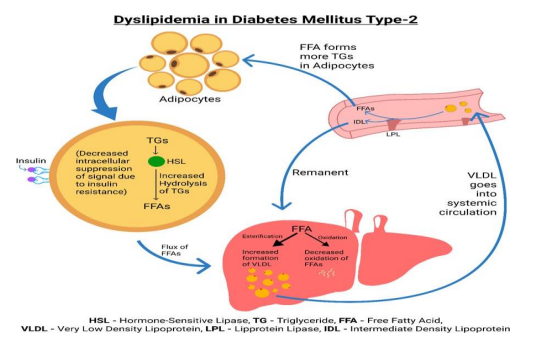Evaluation of Glycemic and Lipid Profiles Among Patients With Type 2 Diabetes Mellitus in Derna City - Libya
DOI:
https://doi.org/10.63318/waujpasv3i2_39Keywords:
Type 2 diabetes mellitus, HbA1c, Lipid profile, Lifestyle factors, Glycemic control, LibyaAbstract
Type 2 Diabetes Mellitus (T2DM) is linked to inadequate glycemic and lipid regulation, which can lead to severe long-term complications. This study aimed to assess the glycemic (HbA1c, FBG) and lipid (LDL, HDL, TG) profiles among T2DM individuals in Derna, Libya, and investigate their relationships with demographic characteristics and smoking patterns. A cross-sectional investigation was performed on sixty-one adult T2DM individuals in March 2025, with data examined using correlation, ANOVA, and multiple linear regression to evaluate the variables. The presented results indicate that 68.3% of subjects had inadequate glycemic control (HbA1c >7%). Additionally, dyslipidemia was quite prevalent, with elevated TG in 58.3% and LDL in 81.7%. There was a substantial, statistically significant correlation between HbA1c and FBG (r=0.72), BMI (r=0.45), and LDL (r=0.38). Furthermore, elevated HbA1c values were substantially associated with smoking and lower educational achievement (p < 0.05). Regression analysis identified FBG, BMI, and smoking as independent predictors of HbA1c, highlighting the multi-factorial nature of metabolic control. The study's conclusion emphasizes the high prevalence of poor glycemic and lipid control in this population as well as the significant impact of sociodemographic factors and lifestyle modifications. In comparable resource-constrained settings, combining patient-focused therapies with biochemical evaluation is recommended to enhance overall diabetes management.
Downloads

Downloads
Published
Issue
Section
License

This work is licensed under a Creative Commons Attribution-NonCommercial 4.0 International License.
This journal uses Creative Commons Attribution-Noncommerical 4.0 International License (CC BY-NC 4.0), which permits use, sharing, adaptation, distribution and reproduction in any medium or format, as long as you give appropriate credit to the original author(s) and the source, provide a link to the Creative Commons license, and indicate if changes were made. To view a copy of this license, visit https://creativecommons.org/licenses/by-nc/4.0/.
Copyright of articles
Authors retain copyright of their articles published in this journal.




